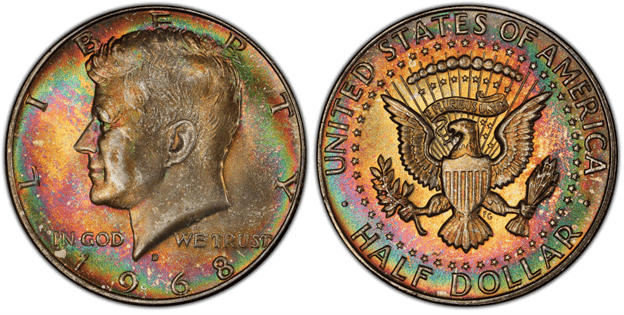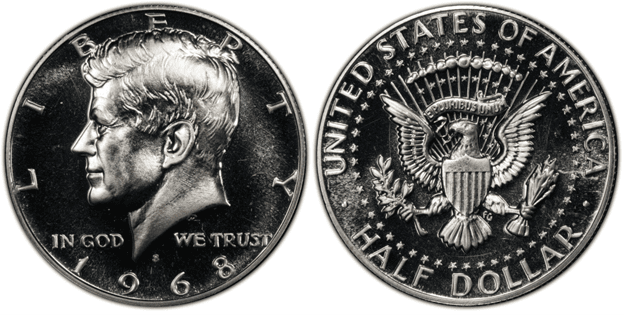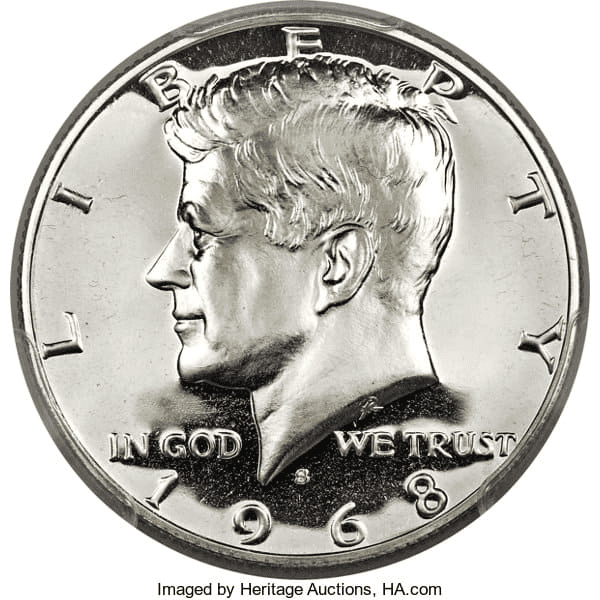What Is The 1968 Kennedy Half Dollar Made Of?
The United States Mint still produces the Kennedy half dollar, a fifty-cent piece that was originally produced in 1964. It was approved by Congress just over a month after the assassination of John F. Kennedy, the 35th president of the United States, and was meant to serve as a memorial.
The new coins were struck starting in January 1964 thanks to the Mint sculptors Gilroy Roberts and Frank Gasparro’s use of already completed pieces.
Upon their debut in March 1964, the silver coins were coveted by collectors and those seeking memory of the late president. Despite a significant increase in production by the Mint, the denomination was rarely seen in circulation.
The stockpiling of early Kennedy half dollars escalated as the price of silver continued to rise; many of these coins have been melted for their silver content. Even though the amount of fine silver was lowered from 90% to 40% (silver clad) starting with 1965-dated coins, the coin saw limited use.
As it was minted post-1965, the 1968 Kennedy half dollar was struck in 60% copper is a 40% silver cladding. Gilroy Roberts created the coin’s obverse face, which has a profile bust picture of John F. Kennedy with the word “LIBERTY” running along the top rim and the year of mintage below his head. “IN GOD WE TRUST” is written on both sides of his neck.
Frank Gasparro created the reverse face, which shows an eagle with wide wings holding an olive branch on one foot and a bundle of arrows on the other. A circle of stars surrounds the eagle, and the words “E PLURIBUS UNUM” are displayed on a banner over its head.
The words “UNITED STATES OF AMERICA” are written along the upper rim, while “HALF DOLLAR” is written along the lower rim. Today, Kennedy half dollars are mostly struck for collectors despite having undergone a number of special editions and sets.
1968 Kennedy Half Dollar Rarities And Varieties
1968 Half Dollar With No Mint Mark
1968 saw the return of the mint mark which had been removed from coins to try to combat collecting. During 1968 no Kennedy half dollars were minted in Philadelphia, meaning there are no coins of this type produced in this year that was lacking a mint mark (as Philadelphia never added a mint mark to their coins at this time).
1968-D Half Dollar
Year: 1968
Face Value: $0.50
Composition: 40% silver and 60% copper
Total Weight: 11.50 g
Diameter: 30.6 mm
Thickness: 2.15 mm
Edge: 150 Reeds
Minted in: Denver
Quantity Minted: 246,951,930

photo source: www.pcgs.com
1968-S Half Dollar
Year: 1968
Face Value: $0.50
Composition: 40% silver and 60% copper
Total Weight: 11.50 g
Diameter: 30.6 mm
Thickness: 2.15 mm
Edge: 150 Reeds
Minted in: San Francisco
Quantity Minted: 3,041,506

photo source: www.pcgs.com
All proof-quality coins were minted in San Francisco during this year.
List of errors
There are no documented examples of widespread errors seen in 1968 Kennedy half dollars, meaning that errors seen are on a coin-by-coin basis. There is however one highly sought-after example of the 1968 half dollar which is the 1968-S PCGS PR70 Deep Cameo.

photo source: somethingborrowedpdx.com
San Francisco-minted Kennedy half dollars from 1968 are extremely common. Finding one in great condition, however, is a very different story. When it comes to quality and condition, this example is at the top of the heap. It is a proof coin with a PCGS grade of 70.
Additionally, it has the coveted deep cameo designation. In November 2017, an auction was held for it. It also sold for a staggering $21,600.
For those not in the know, deep cameo, or DCAM is used to describe coins—typically Proofs and proof-like coins—with severely frosted designs and writing that contrast with the fields is frequently referred to as black and white cameos.
How Much Is A 1968 Kennedy Half Dollar Worth Today?
In circulated condition, this coin is worth at least its weight in silver. The melt value of this coin in silver as of June 2022 is $3.13. This melt value is calculated using the silver spot price of $21.17 per ounce as of today.
In terms of value, the 1968 Kennedy half dollar can command some pretty respectable prices. Issues from Denver that are rated Good-4 to Approximately Uncirculated-50 are worth $3.65. This is the typical value for Kennedy half dollars from 1968.
In Uncirculated (MS-60), the value rises to $6.14, and in Uncirculated, it rises to $19. (MS-65). Examples of MS-66 are worth $60, and those of MS-67 could be worth up to $1,800. San Francisco proofs, meanwhile, are worth $8.39 each.
In the PR-65 to PR-66 grade range, samples of the Inverted “S” variant are said to have sold for between $400 and 700 dollars, however, private auctions have seen instances fetch premiums of up to $2,500.
How Does The Grading System Work?
The Sheldon Scale is used by numismatists to provide a numerical value to coins. The Sheldon Scale goes from poor (P-1) to perfect mint state (P-1) (MS-70). Coins were originally evaluated using words to reflect their condition (Good, Fair, Excellent, Etc.). Unfortunately, coin collectors and dealers had different ideas about what each of these terms represent.
Professional numismatists joined together in the 1970s and established CoinGrading standards. These numismatists now assign grades at key places on the seventy-point scale, using the most regularly utilized numeric points in conjunction with the original adjective grade. The following are the most common coin grades:
-
-
- (P-1) Poor – Indistinguishable and probably damaged; if used, must have a date and mintmark; otherwise, rather battered.
- (FR-2) Fair – Nearly smooth, but without the damage that a coin graded Poor often possesses. The coin must have enough detail to be identified.
- (G-4) Fair – Inscriptions have merged into the rims in some areas, and important elements have been mostly erased.
- (VG-8) Very Good- A little weathered, but all of the primary design elements are visible, albeit faintly. There is little if any, central detail left.
- (F-12) Good – The item is very worn, yet the wear is even, and the overall design details stand out clearly. Rims are almost completely isolated from the field.
- (VF-20) Very Fine – Moderately weathered, with some finer features still visible. The motto or all letters of LIBERTY are readable. Both sides of the coin have entire rims that are separated from the field.
- (EF-40) Extremely Fine – Gently used; all gadgets are visible, and the most important ones are bold. The finer details are bold and clear, however, light wear may be seen.
- (AU-50) Uncirculated – Slight evidence of wear on the coin’s design’s high points; may have contact marks; eye appeal should be adequate.
- (AU-58) Uncirculated Choice – Slight traces of wear, no severe contact marks, almost full mint shine, and great eye appeal.
- (MS-60) Mint State Basal – Strictly uncirculated; no indication of wear on the coin’s highest points, but an unsightly coin with reduced luster, visible contact marks, hairlines, and other flaws.
- (MS-63) Mint State Acceptable – Uncirculated, but with contact scratches and nicks, little reduced shine, but otherwise appealing appearance. The strike is weak to average.
- (MS-65) Mint State Choice – Uncirculated with great mint shine, very little contact blemishes, and exceptional eye appeal. The strike is unusually severe.
- (MS-68) Mint State Premium Quality – Uncirculated with superb luster, no obvious contact marks to the naked eye, and exceptional eye appeal. The strike is quick and appealing.
- (MS-69) Almost Perfect Mint State – Uncirculated with perfect brilliance, a sharp and appealing strike, and extremely good eye appeal. A near-perfect coin with minor imperfections in the planchet, strike, and contact markings (seen only under 8x magnification).
- (MS-70) Mint State Perfect – Under 8x magnification, there are no tiny imperfections discernible; the strike is crisp, and the coin is perfectly centered on a beautiful planchet. Rarely seen on a coin, this coin is bright and whole, with original luster and exceptional eye appeal.
-
Where To Buy 1968 Kennedy Half Dollar?
Most specimens of 1968 Half Dollars can be purchased and sold on online markets due to the small number of rare or exceptional coins seen in this mintage year. Only if you believe that the coin you possess possesses outstanding attributes should you give specialized stores, auctions, and dealers a thought.
Coin collecting sites like the U.S. Coin Forum. is a good place to ask questions if you’re unsure of the rarity of your 1968 half dollar and to grade your coin, services such as PCGS are recommended.
FAQs
Is the 1968 D Kennedy half dollar silver?
Yes, Kennedy Half Dollars from 1968 are comprised of 40% silver.
Which Kennedy half dollars are most valuable?
Outside of the Deep Cameo we’ve talked about in this article. The most expensive Kennedy half dollar ever sold was a 1964 PCGS SP68 SMS which sold for a jaw-dropping $156,000 in 2019. Kennedy half dollars minted in 1964 hold a greater value than 1968 half dollars because they have a 90% silver composition.
Are all 1968 half dollars Silver?
Yes, all 1968 half dollars are comprised of 40% silver. Kennedy Half Dollars minted in 1964 are made of 90% silver, and those produced after 1971 have no silver content at all.



